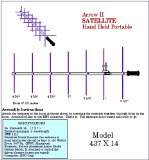
HF Army surplus antenna linked to a Kenwood 480SAT working HF.
SPAWAR Systems Center Pacific has developed a technology that uses the magnetic induction properties of sodium chloride (salt) in sea water to create UHF/VHF/HF antenna.
Video Rating: 4 / 5


very nice!
Hrmm…how about on a windy day though?
can you use fresh water?
WWII
On a windy day, let’s hope you’re broadcasting on UHF.
Why not pump down if your able to use the tube to enclose it, it seems you could use it with a lower power pump and keep recirculating the water. Could use some sort of telecoping tube to adjust the antenna size. Mount it on a small bouy it could collapse into itself making it self contained other than the cable to your radio.
Brilliant!
I want one!
I am looking forward to seeing this for sale at the marina or radio shop
@nomel23
how about using plastic tubing filled with conductive liquid, maybe something better than saltwater, maybe water fortified with some mineral or chemical
======================
Reinventing the wheel I would say.
======================
And you are probably totally right, in this case on the internal material and the interfaces have any (latent) patentability … but in the US the patent laws have gone bizerk so you never know.
Where can I get/build one?
RE: ultraviolet lasers….. Don’t make a conducting path to a storm cloud, ” If you do , make sure your supper well grounded.
Wouldn’t noise from ionizing / deionizing air molecules be a problem. If not then could ionizing lasers create a path into the ionosphere for global communication?
Great, simplistic, and very useful invention. What prohibits you from going above UHF range. I like the idea of recycling the water. Create one that is Battery-operated.
Can you create a simple radio that uses the water itself as an antenna. Can you go above UHF range.
make it so it creates energy from salt water and charges a batery
make it so it creates energy from salt water and charges a battery that can be used to move the pump and charge the radio
See paper Fayad, H.; Record, P.; Electronics Letters Volume: 42 , Issue: 3
Digital Object Identifier: 10.1049/el:20063633 Publication Year: 2006 , Page(s): 133 – 134. What is the purpose of the permanent magnet. We found the salt in water ( sea water) only acts as lossy dielectric
Hmm – asking for a signal report on a repeater?
Nice toy and nice implementation, but is this a serious option for a sea going craft? How do you deal with wind? Why not just have a plastic pipe with a variable amount of water in?
нихера се…
Reminds me of when I was a kid and my older brothers tricked me into peeing on an electric fence.
so its basically using the water as an antenna and the height of the water being pumped up makes it work as a bigger antenna? I originally got the impression that it was sending signals through the water just by the device sitting in the water considering the water is always connected it would be like one giant antenna, it apparently wouldn’t work like that..
I have another thought, could a person use a cup of salt water to make a UHF/VHF antenna for a TV?
Why not waste the taxpayers money in Vegas? Much more fun! And Harry will love you.
I got to meet Mr. Daniel Tam when my engineering class got to take a high security tour of Spawar Pacific. Quite an amazing invention, because I got to put my finger in between the coil so that we could listen to the radio. A very amazing day…
G’day mate, thanks for the upload. Have you ever tried inducing a lamina flow to the water? Or would the field be the same as the flow of water droplets?